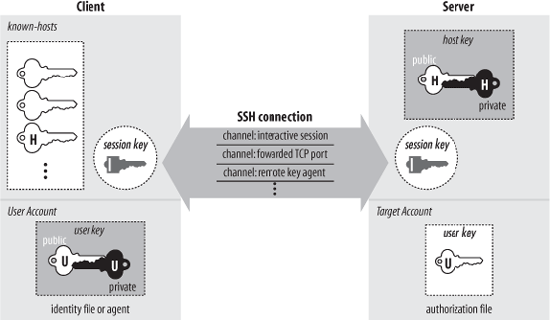The Architecture of an SSH System
SSH has about a dozen distinct, interacting components that produce the features we’ve covered. [3.1] Figure 3-1 illustrates the major components and their relationships to one another.

Figure 3-1. SSH architecture
By “component” we don’t necessarily mean “program”: SSH also has keys, sessions, and other fun things. In this section we provide a brief overview of all the components, so you can begin to get the big picture of SSH:
- Server
A program that allows incoming SSH connections to a machine, handling authentication, authorization, and so forth. In most Unix SSH implementations, the server is sshd.
- Client
A program that connects to SSH servers and makes requests, such as “log me in” or “copy this file.” In OpenSSH and Tectia, the major clients are ssh, scp, and sftp.
- Session
An ongoing connection between a client and a server. It begins after the client successfully authenticates to a server and ends when the connection terminates. Sessions may be interactive or batch.
- Key
A relatively small amount of data, generally from tens of to 1,000 or 2,000 bits, used as a parameter to cryptographic algorithms such as encryption or message authentication. The key binds the algorithm operation in some way to the key holder: in encryption, it ensures that only someone else holding that key (or a related one) can decrypt the message; in authentication, it allows ...
Get SSH, The Secure Shell: The Definitive Guide, 2nd Edition now with the O’Reilly learning platform.
O’Reilly members experience books, live events, courses curated by job role, and more from O’Reilly and nearly 200 top publishers.

